Corrosion of Silver-Plated Copper Conductors - NEPP
Corrosion of Silver-Plated Copper Conductors - NEPP
Corrosion of Silver-Plated Copper Conductors - NEPP
Create successful ePaper yourself
Turn your PDF publications into a flip-book with our unique Google optimized e-Paper software.
Figure 2. Colour photomicrographs <strong>of</strong><br />
typical 'red-plague' corrosion areas on<br />
braiding, as circled in Figure 1.<br />
a. Red and green corrosion products<br />
associated with two strands that have<br />
completely broken; the brittle fracture<br />
surfaces are arrowed ( x 100);<br />
b. <strong>Corrosion</strong> products are black (1), red<br />
(2) and green-blue (3)<br />
Figure 3. Scanning electron photomicrographs<br />
<strong>of</strong> fractured ends <strong>of</strong> strands from braid shown<br />
in Figure 2a. The Cu20 phases are<br />
characteristically seen as ruby-red crystals<br />
under crossed polar light. CuO appears black<br />
under the same conditions<br />
312<br />
Examination <strong>of</strong> the corroded strands in the SEM showed them to consist entirely <strong>of</strong><br />
brittle oxidised copper crystals. Adjacent strands supported crystals <strong>of</strong> cuprous oxide<br />
which were adherent to the silver platings (Fig. 3). Only the presence <strong>of</strong> copper, silver<br />
and a trace <strong>of</strong> chlorine were detected by EDAX analysis <strong>of</strong> the strand surfaces.<br />
Auger examination revealed that both the silver surfaces, and the copper-oxide<br />
films were contaminated by chlorine and fluorine to a maximum <strong>of</strong> 5 at%. Depth<br />
pr<strong>of</strong>iles revealed fluorine in t lie silver plating to a depth <strong>of</strong> 40 Å. Further Auger<br />
analyses also detected the presence <strong>of</strong> chlorine and fluorine at the central area <strong>of</strong> the<br />
strand fracture surface. 1 his area was composed entirely <strong>of</strong> copper-oxide crystals<br />
(Fig.4). Both chlorine and fluorine, when present as free ions, would tend to be an<br />
accelerating factor in any galvanic corrosion mechanism.<br />
The micro-sections <strong>of</strong> the corroded 125Ω cable are described in Figures 5-9. Only a<br />
few (approximately 3%) <strong>of</strong> the 143 strands that make up the braid have corroded. The<br />
loose-fitting outer jacket has at some stage retained a liquid that promoted galvanic<br />
corrosion at minute locations <strong>of</strong> damaged silver. The average silver-plating thickness<br />
<strong>of</strong> these strands is 2 – 3μm. <strong>Copper</strong> oxides are present on the outside surfaces <strong>of</strong> silver<br />
strands at locations far from the corrosion sites. This is important as it gives the<br />
impression, from visual inspections, that the amount <strong>of</strong> corrosion and red plague is<br />
more extensive than initially apparent and illustrates that the braid must have been<br />
almost totally immersed in a liquid to enable the transfer <strong>of</strong> copper ions to these<br />
locations. On drying out, tile liquid has precipitated at least three copper compounds:<br />
blue cupric hydroxide (Cu(OH)2), red-coloured cuprous-oxide crystals (Cu20) and<br />
black cupric-oxide layers (CuO), onto the silver surfaces. The red colouration on the<br />
braid is likened to a process <strong>of</strong> bleeding out <strong>of</strong> copper ions from occasionally<br />
corroding fissures. On drying, capillary forces tend to concentrate oxide precipitation<br />
at the braid cross-hatched turns.<br />
ESA Journal 1984, Vol. 8






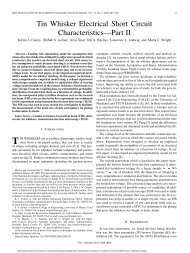
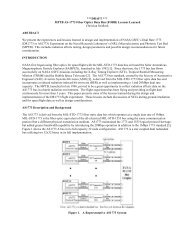

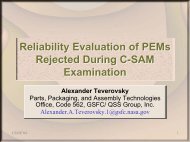
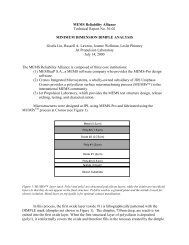
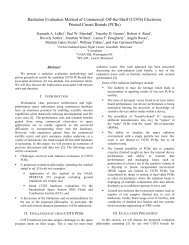
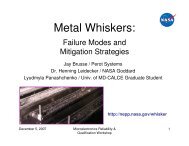

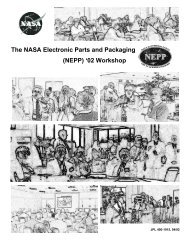

![mil-std-2223 [test methods for insulated electric wire] - NEPP](https://img.yumpu.com/4036001/1/190x249/mil-std-2223-test-methods-for-insulated-electric-wire-nepp.jpg?quality=85)